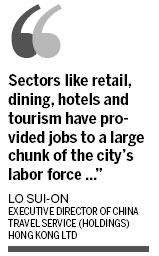Time to capitalize on surging tourist flows
Updated: 2012-07-01 08:06
By Li Tao in Hong Kong(China Daily)
|
|||||||||

In the 15 years since its return to China, Hong Kong has taken several giant strides to establish itself as a premier economic destination in the world. At the same time, the city has also emerged as one of the most popular tourist destinations in Asia.
Lo Sui-on, executive director of China Travel Service (Holdings) Hong Kong Ltd, says that the major turning point for the Hong Kong economy, particularly the services industry, was the introduction of the Individual Visit Scheme in 2003. According to Lo, the plan was just the right medicine to heal the economic ailments of Hong Kong at that time.
Recollecting the dark days, Lo says the city was reeling from the aftermath of SARS, which had almost blocked off all tourist arrivals to the city.
Added to that was surging unemployment rates of more than 8 percent, a legacy of the Asian financial crisis in 1997.
The steady influx of tourists from the mainland after the plan was introduced on July 28, 2003 has more than paid off and continues to be a strong magnet for overall economic growth in Hong Kong even today, says Lo, a deputy to the 11th National People's Congress.
Hong Kong is known for its advanced business and trade activities. Though the city is one of the leading international financial centers with many people holding high-paying jobs, the majority of the city's population are the "actual beneficiaries of the thriving tourism economy", Lo says.
"It is essentially a service-dominated economy. Sectors like retail, dining, hotels and tourism have provided jobs to a large chunk of the city's labor force and witnessed explosive growth, thanks to the opportunities brought about by tourists, particularly those from the mainland."
According to the Hong Kong Tourism Board, Hong Kong had a record 41.9 million visitors in 2011, a 16.4 percent increase over the previous year. It was also the first time that the number of arrivals surpassed the 40 million mark.
More than 28 million of the travelers hailed from the mainland last year, accounting for 67 percent of the city's total arrivals. Total tourism expenditure reached HK$253 billion ($32.6 billion) in 2011, up 20.5 percent from the previous year, according to government statistics.
Though the global economic woes have triggered some concerns for the Hong Kong economy, the city has still been able to keep its jobless rate at low levels, thanks to the influx of mainland spenders, Lo says.
The unemployment rate in Hong Kong stood at an average of 3.4 percent during 2011. The rate further fell to 3.2 percent during the three-month period ended in January, signifying "a state of full employment in the labor market", according to government officials.
"The resilience of the local job market and easing inflationary pressures have given a push to retail sales and spurred domestic demand in Hong Kong, as do the continued strong visitor inflows," Donna Kwok, Greater China economist from HSBC, said in a research report in May commenting on the city's better-than-expected retail sales figures.
She highlighted the contribution of continued robust inflows of tourists from the mainland that averaged well over 2 million per month.
The plan has since been extended to 49 cities on the mainland, while a number of others are eager to be added to the list.
On the other hand, Hong Kong also needs to improve further in many aspects to cater to the increasing demand, Lo says.
Accommodation cost is still a major issue in Hong Kong. It is important for the city to be well-prepared to accommodate the 45 million or so visitors every year, or else it may find itself stretched to the extremes.
litao@chinadaily.com.cn
(China Daily 07/01/2012 page8)